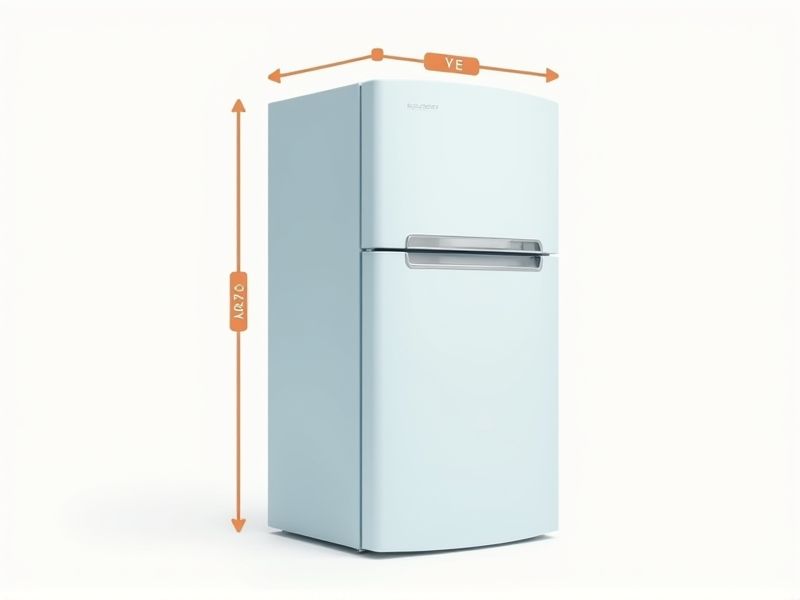
When selecting a refrigerator, it's helpful to know that standard dimensions typically range from 28 to 36 inches in width, 61 to 71 inches in height, and 28 to 34 inches in depth. For instance, a common full-size refrigerator might measure about 36 inches wide, 70 inches tall, and 33 inches deep, not including handles or doors that might protrude. Be sure to measure your available space carefully and account for door clearance, ventilation, and pathways for delivery. Knowing these standard sizes can make it much easier to narrow down choices and ensure a smooth installation process in your home.
Capacity In Liters Or Cubic Feet
Refrigerator capacity is commonly measured in liters or cubic feet, with most models offering a range from 5 to 30 cubic feet, accommodating various household sizes and needs. For instance, a standard refrigerator for a family of four typically ranges from 18 to 25 cubic feet, providing ample storage for groceries while optimizing space. Energy-efficient models often include features that enhance organization, such as adjustable shelving and designated compartments, ensuring effective use of available capacity.
Width Of The Unit
The standard width of a refrigerator typically ranges from 30 to 36 inches, although compact models can be as narrow as 24 inches. A width of 36 inches is commonly found in larger, side-by-side or French door designs, providing ample storage space for families. When selecting your refrigerator, consider the available kitchen space to ensure a proper fit, allowing for at least 1 inch of clearance on each side for ventilation. It's essential to measure your kitchen's doorway and hallways as well to avoid any challenges during installation.
Height Of The Unit
The standard height of a refrigerator typically ranges from 5.5 to 6.5 feet, accommodating various kitchen layouts and user preferences. A height of 66 inches, for instance, is common for many models, ensuring compatibility with cabinets and countertops. It's important to measure your space accurately before making a purchase; consider an allowance of 2-3 inches for ventilation. Proper height selection not only enhances accessibility but also contributes to the overall aesthetics of your kitchen.
Depth With And Without Doors
The standard refrigerator depth typically measures between 28 to 34 inches without doors, allowing for easy integration into kitchen spaces. When including doors, this depth ranges from 29 to 36 inches, accommodating additional clearance for the door swing. Models designed for built-in applications often have a depth of 24 inches, ensuring a seamless look with cabinetry. You should consider these dimensions to optimize kitchen layout and functionality while ensuring your refrigerator fits comfortably.
Door Clearance Space
When selecting a refrigerator, ensuring an adequate door clearance space is essential for optimal functionality. Typically, a minimum clearance of 1 inch on the sides and 1 inch on the top is recommended to facilitate proper airflow and prevent overheating. For French door models, account for an additional 5-10 inches of clearance in front to enable full access without obstruction. Your consideration of these dimensions can significantly enhance appliance longevity and usability in your kitchen layout.
Interior Shelving Layout
The interior shelving layout of a refrigerator significantly impacts its efficiency and usability, with standard configurations including adjustable shelving, which allows for customizable spacing. Energy-efficient models often feature glass shelves that minimize spills and improve visibility, while some contain specialized compartments designed for fruits, vegetables, or dairy products to optimize freshness. A standard refrigerator typically includes 3 to 5 removable shelves, providing adequate space for various food items, while door bins can accommodate smaller containers and condiments. Your choice of shelving can enhance organization, making it easier to access food and reduce food waste.
Drawer Dimensions
Refrigerator drawer dimensions typically range from 18 to 30 inches in width and 16 to 20 inches in height, accommodating various storage needs. A standard depth of 24 inches allows for efficient organization while fitting seamlessly into kitchen spaces. When selecting a refrigerator, consider ensuring your drawers can handle at least 50 pounds of weight, ideal for holding fruits, vegetables, and other staples. Properly sized drawers not only enhance accessibility but also improve airflow, maintaining optimal freshness for your food items.
Energy Efficiency Standards
Energy efficiency standards for refrigerators are crucial in reducing energy consumption and lowering utility bills. Modern models often comply with the Energy Star certification, which signifies that they use at least 9% less energy than the federal standards set by the Department of Energy. In 2022, the average energy consumption for a refrigerator was approximately 450 kWh per year, highlighting the advancements in technology aimed at enhancing energy efficiency. Investing in an energy-efficient refrigerator can save you up to $200 over its lifetime compared to less efficient models.
Ice Maker And Dispenser Placement
Refrigerators with built-in ice makers and dispensers enhance convenience and functionality, typically positioned in the door or on the front accessible panel. Models featuring a door-mounted ice maker can store up to 10 pounds of ice, while an internal ice maker may provide a sleeker appearance and more internal space. When considering your options, check the layout for ease of access--most dispensers are designed for one-handed operation, allowing you to fill glasses with a simple push. Understanding these placements ensures you can maximize both storage efficiency and usability in your kitchen.
Freezer Compartment Size
A standard refrigerator typically features a freezer compartment that occupies approximately 30% to 40% of the total interior space. For an average model, this translates to around 3 to 5 cubic feet of frozen storage capacity. Many modern refrigerators offer adjustable shelving and drawers within the freezer, enhancing accessibility and organization for frozen foods. When choosing a refrigerator, consider your freezing needs; a larger freezer compartment is beneficial for families or individuals who buy in bulk or frequently prepare meals ahead of time.
